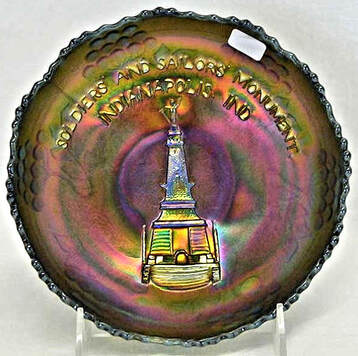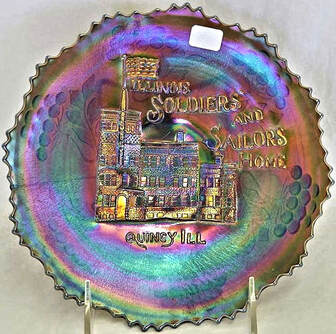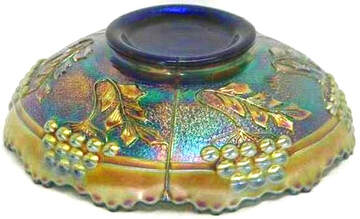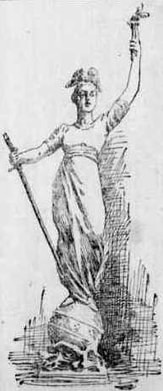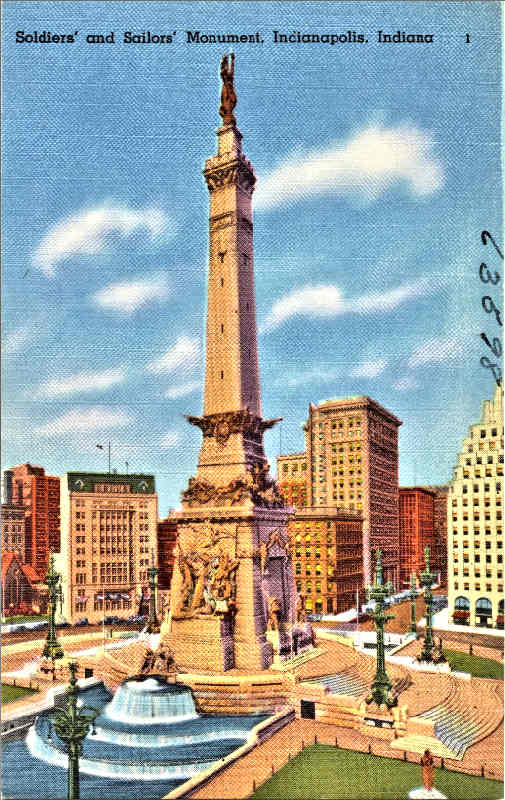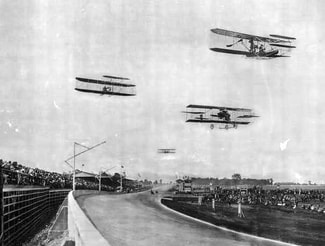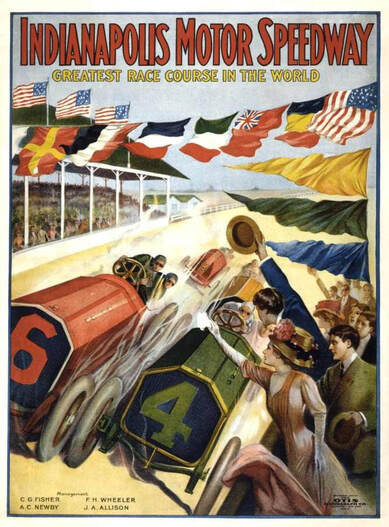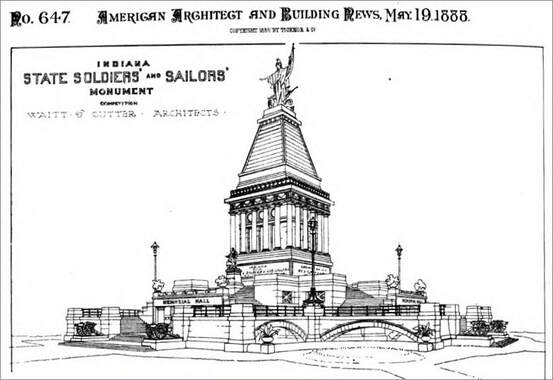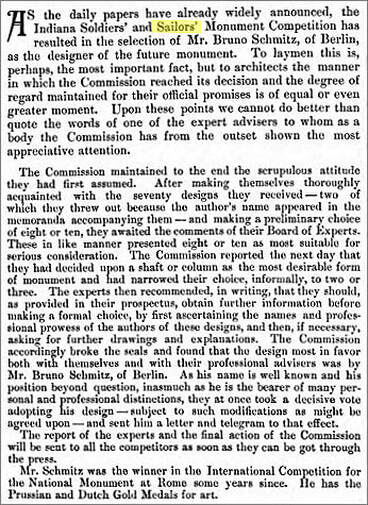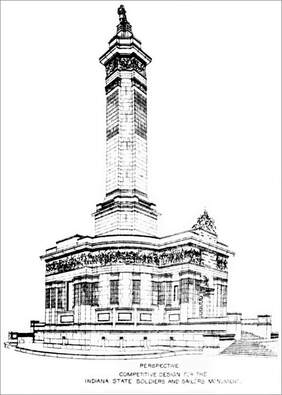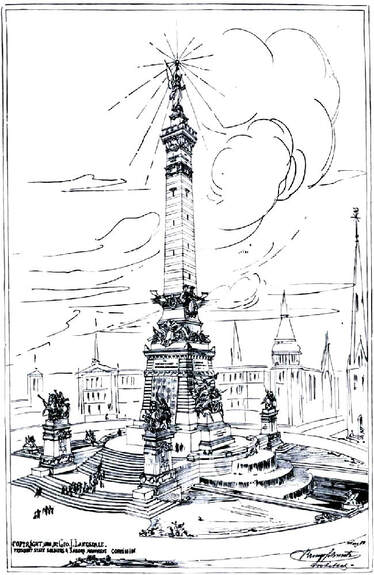Soldiers' and Sailors' Monument, Indianapolis, Fenton - The Story Behind The Glass
Based on, and updated from, our original article published in May 2015.
The massive 284 foot high Indiana State Soldiers' and Sailors' Monument has the distinction of being the very first such structure in the USA that was dedicated to the “common” soldier. Standing just a few feet shorter than the Statue of Liberty, the Soldiers' and Sailors' Monument is an imposing and impressive structure that dominates the wide public space in central Indianapolis in which it stands. Its history and significance as both a focal point and an icon (representing courage and valour) in the city are fascinating. Uncovering the narrative – the “big picture” – reveals much, including why and when the Carnival Glass pieces that feature the Monument are likely to have been made.
The Soldiers' and Sailors' Monument, Indianapolis lettered piece is extremely rare. It is known in blue only, in both seven inch plate and bowl shapes (the latter a touch under seven inches), and in numbers that you can count on one hand.
The massive 284 foot high Indiana State Soldiers' and Sailors' Monument has the distinction of being the very first such structure in the USA that was dedicated to the “common” soldier. Standing just a few feet shorter than the Statue of Liberty, the Soldiers' and Sailors' Monument is an imposing and impressive structure that dominates the wide public space in central Indianapolis in which it stands. Its history and significance as both a focal point and an icon (representing courage and valour) in the city are fascinating. Uncovering the narrative – the “big picture” – reveals much, including why and when the Carnival Glass pieces that feature the Monument are likely to have been made.
The Soldiers' and Sailors' Monument, Indianapolis lettered piece is extremely rare. It is known in blue only, in both seven inch plate and bowl shapes (the latter a touch under seven inches), and in numbers that you can count on one hand.
|
Above: Fenton's Soldiers' and Sailors' Monument, Indianapolis. This one is an ice cream shaped bowl in blue, which to date, is the only known example in this shape. Picture courtesy of Seeck Auctions.
The exterior pattern on both of these designs is Berry and Leaf Circle (shown right), which is a known Fenton exterior pattern (and so confirmed that Fenton was the maker of these amazing lettered patterns). It is a design that the late Don Moore used to fondly refer to as the Horse Chestnut pattern. Moore’s explanation of this name is rather interesting so let’s quote him: "I can not find that Mrs Hartung ever named this pattern. She does state in her Book 1 that the small fruit looked like cherries. Bill Edwards in his books refers to it as “Berry & Leaf Circle” and also “Panelled Berry”. Wily Aldis also called it “Berry & Leaf Circle” in his study of reverse patterns. Mrs Presznick makes no reference to it that I can find. You may call it what you wish … and I am sure it comes up regularly in your daily conversations … but Horse Chestnut is an easier tag for me." Don Moore “The Horse Chestnut” Pattern from Carnival Glass A Collection of Writings. |
It is important not to confuse the Soldiers' and Sailors' Monument design, with the similarly named Illinois Soldiers' and Sailors' Home, Quincy, which was also made by Fenton. Shown below is a blue plate, courtesy of Seeck Auctions. The Quincy design is found on seven to eight inch plates in blue and also in marigold. Above: the exterior pattern Berry and Leaf Circle (aka "Horse Chestnut").
Picture courtesy of Seeck Auctions. |
|
The Indiana State Monument was conceived in 1887, and an International competition for its design was won by the German architect, Bruno Schmitz, more of which later. In 1901 the Monument was completed at a cost of almost $600,000. If it were to be built today, the estimated cost would be around $500 Million!
Dedicated on May 15, 1902, it’s a massive and beautiful structure, adorned with statues and many other artistic features, topped off with the crowning female figure of “Victory” – 30 ft high (see image right from the Richmond Times, 1893). Her sword symbolises victory, her torch represents the light of civilisation and the eagle on her brow stands for freedom. Perhaps not surprisingly, this glorious and triumphant figure was dubbed “Miss Indiana” in the newspapers back in the late 1890s. Sadly, the interpretation of her on the actual Carnival Glass pattern is little more than a caricature. In fact, as a general comment, the detail on the design overall is that it lacks detail and precision. Why and when was the Carnival pattern made? The Monument, and the civic space around it, was the focus of many public parades and celebrations, yet none of them fit the time-line of the likely Carnival Glass production, probably around 1910 (give-or-take a few years either side). Undoubtedly the Monument was an icon representing Indianapolis, and it’s possible that Fenton produced it with a view to selling to tourists and visitors who wanted a souvenir of the city. So what was going on in Indianapolis around then? The opening of the Indianapolis Motor Speedway in 1909. |
Postcard right, courtesy
of Boston Public Library |
|
The first race was the National Balloon Race, watched by a crowd of 75,000. Then, in 1910 there was the sensational First National Aviation Meet, hosting the largest number of planes in the air at the same time. The Wright Brothers were flying, the world altitude record was broken, there were stunts and incredible races.
Above: First National Aviation Meet, Indianapolis Motor Speedway, 1910.
Photo by Charles Bretzman. Image in Public Domain. In 1911, the “Indianapolis 500” was first held on Memorial Day at the Indianapolis Motor Speedway to a cheering crowd of 90,000. The New York Tribune even had a special Bulletin Board on Broadway updating news from the Races every 5 minutes. It was a national and international sensation.
Our theory is that Fenton wanted a souvenir for race-goers and tourists that represented Indianapolis. This would explain why the lettering on the piece says Indianapolis, although the building is officially the Indiana State Monument. Having Indianapolis on the piece would have been considered likely to increase its appeal as a souvenir for racing fans. |
Above: Indianapolis Motor Speedway “Greatest Race in the World”.
Image in public domain; Otis Lithograph Co. 1909. |
The Monument design was plain and simple, quick to make, though with neither the panache of the Panther nor the intricacy of Persian Medallion. Perhaps whoever commissioned the item did not accept the design, or perhaps once produced, maybe it missed its target audience. Either it didn’t sell or the bowls and plates were thrown away afterwards – hence the extreme rarity of examples today.
The Monument design was plain and simple, quick to make, though with neither the panache of the Panther nor the intricacy of Persian Medallion. Perhaps whoever commissioned the item did not accept the design, or perhaps once produced, maybe it missed its target audience. Either it didn’t sell or the bowls and plates were thrown away afterwards – hence the extreme rarity of examples today.
The design of the Monument
As mentioned earlier, the design of the Monument was arrived at through an International competition, which was won by the German architect, Bruno Schmitz. The city authorities were keen to ensure that the competition was handled fairly, given the value of public funds that were to be used, and they established a "Commission" to oversee it.
As mentioned earlier, the design of the Monument was arrived at through an International competition, which was won by the German architect, Bruno Schmitz. The city authorities were keen to ensure that the competition was handled fairly, given the value of public funds that were to be used, and they established a "Commission" to oversee it.
|
The competition was announced in various publications, including the "American Architect and Building News", which also published information about its progress, and the eventual winner. The Commission felt it was necessary to explain how they decided the winner, after a "scrupulous attitude" throughout the process. They also felt they had to explain that the winner - Mr. Bruno Schmitz, of Berlin - was the "bearer of many personal and professional distinctions" and that he had won the competition for the National Monument at Rome, as well as Prussian and Dutch Gold Medals (see right). |
Above: extracts from "American Architect and Building News", May 19, 1888 (*). On the left is one of the unsuccessful designs,
and on the right, the explanation from the Commission of their processes and their decision on the Competition winner.
and on the right, the explanation from the Commission of their processes and their decision on the Competition winner.
|
Above: another of the designs submitted to the Commission, from "American Architect and Building News", May 19, 1888. Quite possibly it was on the final shortlist, as it has the columnar design that the Commission were in favour of.(*)
|
* Extracts from "American Architect and Building News", May 19, 1888 sourced from HathiTrust / University of Princeton, digitised by Google.
See more Stories Behind The Glass
